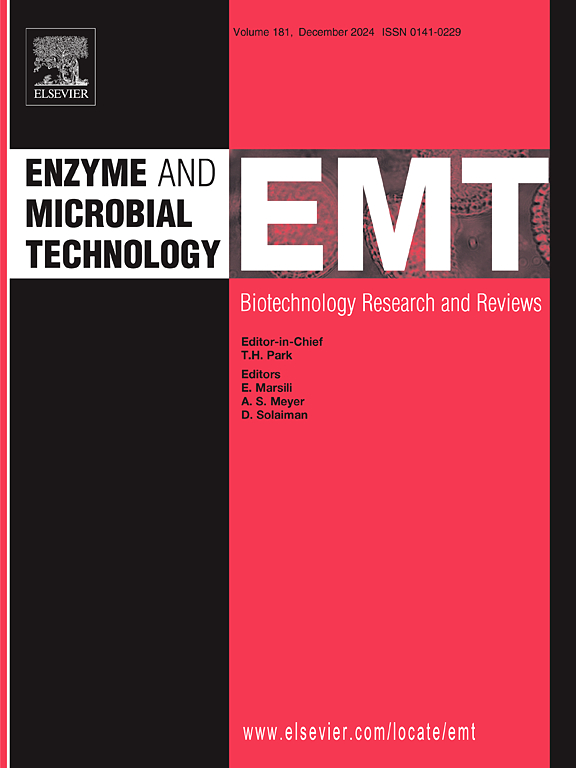A thermostable cellobiose phosphorylase from Thermoclostridium caenicola and its application to in vitro biotransformation
IF 3.7
3区 生物学
Q2 BIOTECHNOLOGY & APPLIED MICROBIOLOGY
引用次数: 0
Abstract
Cellobiose phosphorylase (CBP) catalyzes the reversible phosphorolysis of cellobiose to glucose and α-D-glucose-1-phosphate. CBPs play an important role in the in vivo enzymatic utilization of cellulosic materials. Here we discovered a novel CBP from Thermoclostridium caenicola (TcCBP), displaying 50–75 % sequence homology with previously reported CBPs. Recombinant TcCBP was well expressed in E. coli BL21(DE3), with a 1.6-fold increase in soluble expression levels over the widely-used Clostridium thermocellum CBP (CtCBP). This enzyme exhibited broad pH adaptability, maintaining substantial activities across pH 4.0–7.5 in the synthetic direction and pH 5.0–7.5 in the phosphorolytic direction. Compared to CtCBP, TcCBP displayed the superior thermostability and a nearly 100-fold improvement in "Product-to-Enzyme Ratio" (PE value). The biosynthesis of myo-inositol from cellobiose was conducted by using this CBP along with other four thermophilic enzymes (i.e., phosphoglucomutase, inositol 1-phosphate synthase, inositol monophosphatase, and polyphosphate glucokinase) in one pot without step-by-step addition of enzymes. Approximately 96 mM of myo-inositol was produced from 50 mM of cellobiose. These results indicated that this enzyme could be a potential thermophilic enzyme used for the production of value-added biochemicals by in vitro BioTransformation.
一种耐热性纤维二糖磷酸化酶及其在体外生物转化中的应用
纤维素二糖磷酸化酶(CBP)催化纤维素二糖可逆磷酸解生成葡萄糖和α- d -葡萄糖-1-磷酸。CBPs在纤维素材料的体内酶利用中起着重要作用。在这里,我们发现了一个新的CBP从热梭菌caenicola (TcCBP),显示50 - 75% %序列同源性与先前报道的CBPs。重组TcCBP在大肠杆菌BL21(DE3)中表达良好,可溶性表达量比广泛使用的热胞梭菌CBP (CtCBP)高1.6倍。该酶表现出广泛的pH适应性,在pH 4.0-7.5的合成方向和pH 5.0-7.5的磷酸化方向上保持大量的活性。与CtCBP相比,TcCBP表现出更好的热稳定性,“产物与酶比”(PE值)提高了近100倍。利用该CBP和其他四种嗜热酶(即磷酸葡萄糖化酶、肌醇1-磷酸合成酶、肌醇单磷酸酶和多磷酸葡萄糖激酶)在一个锅中进行了由纤维素糖合成肌醇的生物合成,而无需逐步添加酶。大约96 mM的肌醇由50 mM的纤维二糖产生。这些结果表明,该酶可能是一种潜在的通过体外生物转化生产增值生化产品的嗜热酶。
本文章由计算机程序翻译,如有差异,请以英文原文为准。
求助全文
约1分钟内获得全文
求助全文
来源期刊

Enzyme and Microbial Technology
生物-生物工程与应用微生物
CiteScore
7.60
自引率
5.90%
发文量
142
审稿时长
38 days
期刊介绍:
Enzyme and Microbial Technology is an international, peer-reviewed journal publishing original research and reviews, of biotechnological significance and novelty, on basic and applied aspects of the science and technology of processes involving the use of enzymes, micro-organisms, animal cells and plant cells.
We especially encourage submissions on:
Biocatalysis and the use of Directed Evolution in Synthetic Biology and Biotechnology
Biotechnological Production of New Bioactive Molecules, Biomaterials, Biopharmaceuticals, and Biofuels
New Imaging Techniques and Biosensors, especially as applicable to Healthcare and Systems Biology
New Biotechnological Approaches in Genomics, Proteomics and Metabolomics
Metabolic Engineering, Biomolecular Engineering and Nanobiotechnology
Manuscripts which report isolation, purification, immobilization or utilization of organisms or enzymes which are already well-described in the literature are not suitable for publication in EMT, unless their primary purpose is to report significant new findings or approaches which are of broad biotechnological importance. Similarly, manuscripts which report optimization studies on well-established processes are inappropriate. EMT does not accept papers dealing with mathematical modeling unless they report significant, new experimental data.
 求助内容:
求助内容: 应助结果提醒方式:
应助结果提醒方式:


